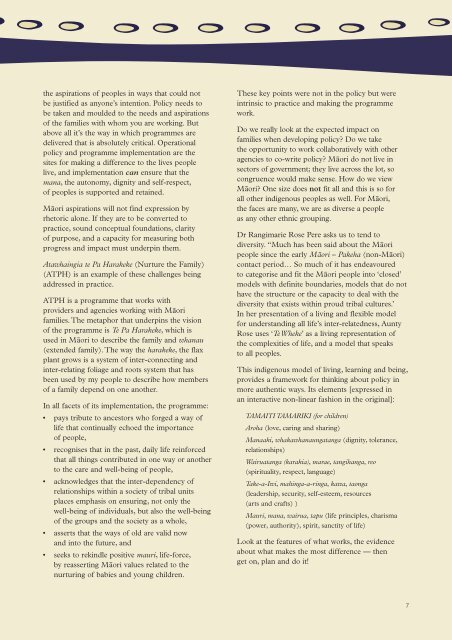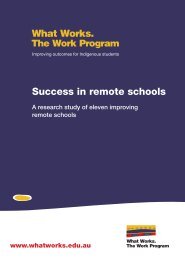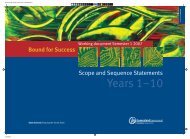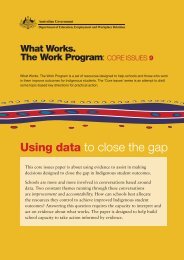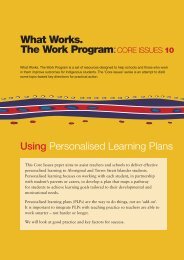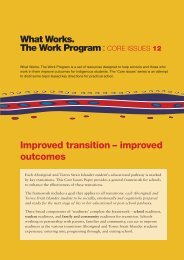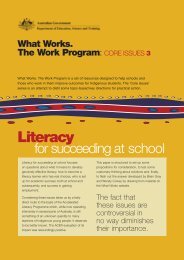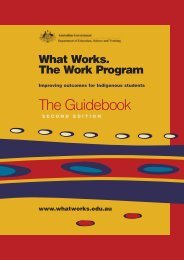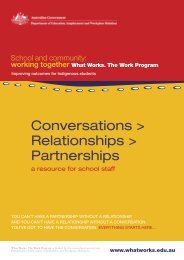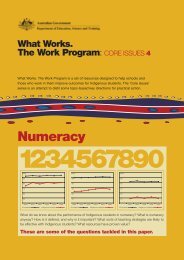Indigenous education: International perspectives - What Works
Indigenous education: International perspectives - What Works
Indigenous education: International perspectives - What Works
Create successful ePaper yourself
Turn your PDF publications into a flip-book with our unique Google optimized e-Paper software.
the aspirations of peoples in ways that could not<br />
be justified as anyone’s intention. Policy needs to<br />
be taken and moulded to the needs and aspirations<br />
of the families with whom you are working. But<br />
above all it’s the way in which programmes are<br />
delivered that is absolutely critical. Operational<br />
policy and programme implementation are the<br />
sites for making a difference to the lives people<br />
live, and implementation can ensure that the<br />
mana, the autonomy, dignity and self-respect,<br />
of peoples is supported and retained.<br />
Māori aspirations will not find expression by<br />
rhetoric alone. If they are to be converted to<br />
practice, sound conceptual foundations, clarity<br />
of purpose, and a capacity for measuring both<br />
progress and impact must underpin them.<br />
Atawhaingia te Pa Harakeke (Nurture the Family)<br />
(ATPH) is an example of these challenges being<br />
addressed in practice.<br />
ATPH is a programme that works with<br />
providers and agencies working with Māori<br />
families. The metaphor that underpins the vision<br />
of the programme is Te Pa Harakeke, which is<br />
used in Māori to describe the family and whanau<br />
(extended family). The way the harakeke, the flax<br />
plant grows is a system of inter-connecting and<br />
inter-relating foliage and roots system that has<br />
been used by my people to describe how members<br />
of a family depend on one another.<br />
In all facets of its implementation, the programme:<br />
• pays tribute to ancestors who forged a way of<br />
life that continually echoed the importance<br />
of people,<br />
• recognises that in the past, daily life reinforced<br />
that all things contributed in one way or another<br />
to the care and well-being of people,<br />
• acknowledges that the inter-dependency of<br />
relationships within a society of tribal units<br />
places emphasis on ensuring, not only the<br />
well-being of individuals, but also the well-being<br />
of the groups and the society as a whole,<br />
• asserts that the ways of old are valid now<br />
and into the future, and<br />
• seeks to rekindle positive mauri, life-force,<br />
by reasserting Māori values related to the<br />
nurturing of babies and young children.<br />
These key points were not in the policy but were<br />
intrinsic to practice and making the programme<br />
work.<br />
Do we really look at the expected impact on<br />
families when developing policy Do we take<br />
the opportunity to work collaboratively with other<br />
agencies to co-write policy Māori do not live in<br />
sectors of government; they live across the lot, so<br />
congruence would make sense. How do we view<br />
Māori One size does not fit all and this is so for<br />
all other indigenous peoples as well. For Māori,<br />
the faces are many, we are as diverse a people<br />
as any other ethnic grouping.<br />
Dr Rangimarie Rose Pere asks us to tend to<br />
diversity. “Much has been said about the Māori<br />
people since the early Māori – Pakeha (non-Māori)<br />
contact period… So much of it has endeavoured<br />
to categorise and fit the Māori people into ‘closed’<br />
models with definite boundaries, models that do not<br />
have the structure or the capacity to deal with the<br />
diversity that exists within proud tribal cultures.’<br />
In her presentation of a living and flexible model<br />
for understanding all life’s inter-relatedness, Aunty<br />
Rose uses ‘Te Wheke’ as a living representation of<br />
the complexities of life, and a model that speaks<br />
to all peoples.<br />
This indigenous model of living, learning and being,<br />
provides a framework for thinking about policy in<br />
more authentic ways. Its elements [expressed in<br />
an interactive non-linear fashion in the original]:<br />
TAMAITI TAMARIKI (for children)<br />
Aroha (love, caring and sharing)<br />
Manaaki, whakawhanaungatanga (dignity, tolerance,<br />
relationships)<br />
Wairuatanga (karakia), marae, tangihanga, reo<br />
(spirituality, respect, language)<br />
Take-a-Iwi, mahinga-a-ringa, kawa, taonga<br />
(leadership, security, self-esteem, resources<br />
(arts and crafts) )<br />
Mauri, mana, wairua, tapu (life principles, charisma<br />
(power, authority), spirit, sanctity of life)<br />
Look at the features of what works, the evidence<br />
about what makes the most difference — then<br />
get on, plan and do it!<br />
7


